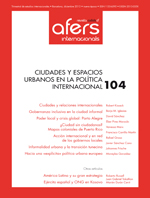Introducción: ciudades y espacios urbanos en la política internacional
Palabras clave:
ciudades, relaciones internacionales, globalización, población, espacios urbanosResumen
Revista CIDOB d’Afers Internacionals, nº 104
Cuatrimestral (septiembre-diciembre 2013)
ISSN:1133-6595 | E-ISSN:2013-035X
Este artículo proporciona una visión de conjunto del desarrollo de los estudios sobre ciudades globales desde una perspectiva político-económica y sociológica, y esboza las implicaciones de estos trabajos para la disciplina de las relaciones internacionales, con especial atención a los lazos conceptuales entre soberanía, territorio y autoridad. El artículo aborda también la importancia de las ciudades y espacios urbanos, en los que actualmente habita más de la mitad de la población mundial y donde en las próximas décadas se producirá el crecimiento demográfico más importante en los países en desarrollo. El artículo pone de relieve que el estudio de las ciudades en la política internacional es una cuestión apremiante para todas las áreas de las ciencias sociales, y en este campo la investigación interdisciplinaria puede resultar enormemente fructífera.
ciudades, relaciones internacionales, globalización, población, espacios urbanos
Citas
Burdett, Richard, et al. The Endless City, Londres: Phaidon, 2007, p. 6.
Buzan, Barry y Little, Richard. International Systems in World History: Remaking the Study of International Relations. Oxford: Oxford University Press, 2000.
Castells, Manuel. The Rise of the Network Society. Oxford: Blackwell Publishers, 1996.
– La question urbaine. París: Maspero, 1972.
Curtis, Simon. «Global cities and the transformation of the international system». Review of International Studies, vol. 37, n.º 4 (2011), p.1923-1947.
Friedmann, John. «The World City Hypothesis». Development and Change, vol. 17, (1986), p. 69-84.
GaWC. Research Bulletin, n.º 300 (2010). (en línea) [actualizado el 13.04.2010] [Fecha de consulta 11.11.2013] http://www.lboro.ac.uk/gawc/rb/rb300.html
Giddens, Anthony. The Nation State and Violence. Cambridge: Polity Press, 1985.
Harvey, David. Social Justice and the City. Londres: Edward Arnold, 1973.
Ruggie, John G. «Territoriality and beyond: Problematizing Modernity in International Relations». International Organization, vol. 47, n.º 1 (1993), p.139-174.
Sassen, Saskia. «The Global City: Introducing a Concept». Brown Journal of World Affairs, vol. XI, n.º 2 (2005), p. 27-43.
– The Global City: New York, London, Tokyo, Princeton, NJ: Princeton University Press, 1991.
– «New York City: Economic Restructuring and Immigration». Development and Change, vol. 17 (1986), p. 85-119.
Scholte, Jan Arte. Globalization: A Critical Introduction. Basingstoke: Palgrave, 2005, 2ª ed.
Scott, James C. How Certain Schemes to Improve the Human Condition Have Failed.Yale: Yale University Press, 1998.
Smith, David A. «The World Urban Hierarchy: Implications for Cities, Top to Bottom». Brown Journal of World Affairs, vol. XI, n.º 2 (2005), p. 45-55.
Tilly, Charles. Coercion, Capital and European States AD 990-1990. Oxford: Blackwell Publishers, 1990.
UN-Habitat. The State of the World’s Cities 2012-2013: Prosperity of Cities, Nueva York: Routledge, 2013.
Weber, Max. From Max Weber: Essays in Sociology. H.H. Gerth & C. Wright Mills (trads. y eds.), Nueva York: Routledge, (1948 [1998]).













